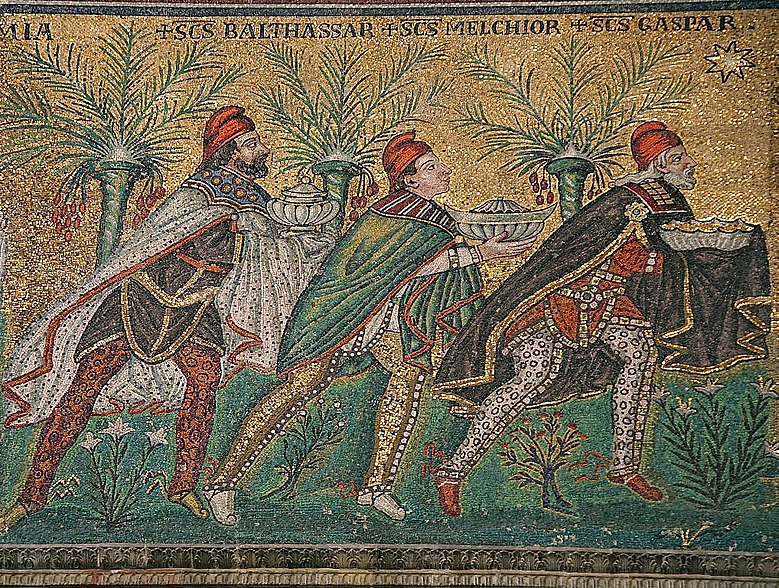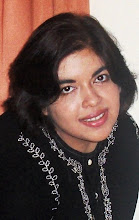
Byzantine art usually depicts the Magi in Persian clothing which includes breeches, capes, and Phrygian caps. Mosaic, ca. 565.
Basilica of Sant'Apollinare Nuovo, Ravenna, Italy - restored above in 18th century. as taken from Wikimedia Commons.
The purple elephant and the little mouse had gone off to the market to stock up on food for all the many house guests that Meady's Musings Production House has been accumulating over the last few weeks when the most funniest thing happened! So funny the purple elephant is rolling on the floor in laughter appearing as if he is in some circus stunt (God forbid he should ever be entrapped in one of those!) as he retells the story with the little mouse...
Apparently the little mouse sat on his shoulder as they went through the market and hid behind his ears every time they noticed a passerby that wouldn't understand that they could be 'clean' mouses in markets. They always do this...and the little mouse advises the purple elephant by whispering into his ear what looks good and what does not...what is too pricey...what is a deal!
So using that tried and tested approach they had already procured honey for the bears (we have since had to buy honey outside our contract after the bee colony strikes earlier on especially to prevent any further Winnie the Pooh impersonations!), bread for the shepherds and even a bouquet of sunflowers for me! :) When that most funniest thing happened!
They saw three men arguing in the middle of the market square! They all had come out of their SUV-sports utility vehicle...each with a smart phone in their hand...arguing that the tallest one who was the driver and the owner of the SUV did not know where he was going as each of their phones gave different directions and that for sure he must have mis-programmed his SUV's GPS! What made it so funny for the purple elephant and the little mouse was the whole scene and antics! The SUV had grinded to a halt right in the middle of the market square kicking up a considerable amount of dust and screeching! And the three men immediately exited from it popping out like if they were compressed hot air inside of there! And all three congregated in a circle pointing at smart phones and then the sky and each trying to out voice the other! But that was not all...
As they argued three large camels seem to appear from no where and used their long necks to scoop a man each up into the air and onto their backs! The expression on each of the men's faces as they all of a sudden grew beards and donned long silky robes is what still has the purple elephant rolling on the floor and I have to tell you my floor tiles are not faring well!
As you might have guessed from that little story the Three Wisemen or the Three Magi or the Three Kings whatever you like to call them are in town! :) And here on the calendar we wish to salute them! :) We had a lot of fun all of last year's Advent calendar long with them and must now again bow to them! And shall do it in this format:
-On Meady's Musings: Who were the Magi? as described on the New Advent (Catholic encyclopedia)and that lovely song with Hugh! ;)
-On UCP: The Time and Circumstances of Their Visit again as described on the New Advent (Catholic encyclopedia).
-On Books and Films Corner: A glimpse of them in the 2006 film The Nativity Story.
So here we go!:
The Time and Circumstances of The Visit of the Magi
As taken from the New Advent
"Time and circumstances of their visit
The visit of the Magi took place after the Presentation of the Child in the Temple (Luke 2:38). No sooner were the Magi departed than the angel bade Joseph take the Child and its Mother into Egypt (Matthew 2:13). Once Herod was wroth at the failure of the Magi to return, it was out of all question that the presentation should take place. Now a new difficulty occurs: after the presentation, the Holy Family returned into Galilee (Luke 2:39). Some think that this return was not immediate. Luke omits the incidents of the Magi, flight into Egypt, massacre of the Innocents, and return from Egypt, and takes up the story with the return of the Holy Family into Galilee. We prefer to interpret Luke's words as indicating a return to Galilee immediately after the presentation. The stay at Nazareth was very brief. Thereafter the Holy Family probably returned to abide in Bethlehem. Then the Magi came. It was "in the days of King Herod" (Matthew 2:1), i.e. before the year 4 B.C. (A.U.C. 750), the probable date of Herod's death at Jericho. For we know that Archelaus, Herod's son, succeeded as ethnarch to a part of his father's realm, and was deposed either in his ninth (Josephus, Bel. Jud., II, vii, 3) or tenth (Josephus, Antiq., XVII, xviii, 2) year of office during the consulship ofLepidus and Arruntius (Dion Cassis, lv, 27), i.e., A.D. 6. Moreover, the Magi came while King Herod was in Jerusalem (vv. 3, 7), not in Jericho, i.e., either the beginning of 4 B.C. or the end of 5 B.C. Lastly, it was probably a year, or a little more than a year, after the birth ofChrist. Herod had found out from the Magi the time of the star's appearance. Taking this for the time of the Child's birth, he slew the male children of two years old and under in Bethlehem and its borders (v. 16). Some of the Fathers conclude from this ruthless slaughter that the Magi reached Jerusalem two years after the Nativity (St. Epiphanius, "Haer.", LI, 9; Juvencus, "Hist. Evang.", I, 259). Their conclusion has some degree of probability; yet the slaying of children two years old may possibly have been due to some other reason — for instance, a fear on Herod's part that the Magi had deceived him in the matter of the star's appearance or that the Magi had been deceived as to the conjunction of that appearance with the birth of the Child. Art and archæology favour our view. Only one early monument represents the Child in the crib while the Magi adore; in others Jesus rests upon Mary's knees and is at times fairly well grown (see Cornely, "Introd. Special. in N.T.", p. 203).
From Persia, whence the Magi are supposed to have come, to Jerusalem was a journey of between 1000 and 1200 miles. Such a distance may have taken any time between three and twelve months by camel. Besides the time of travel, there were probably many weeks of preparation. The Magi could scarcely have reached Jerusalem till a year or more had elapsed from the time of the apperance of the star. St. Augustine (De Consensu Evang., II, v, 17) thought the date of the Epiphany, the sixth of January, proved that the Magi reached Bethlehem thirteen days after the Nativity, i.e., after the twenty-fifth of December. His argument from liturgical dates was incorrect. Neither liturgical date is certainly the historical date. (For an explanation of the chronological difficulties, see Chronology, Biblical, Date of the Nativity of Jesus Christ.) In the fourth century the Churches of the Orient celebrated the sixth of January as the feast of Christ's Birth, the Adoration by the Magi, and Christ's Baptism, whereas, in the Occident, the Birth of Chirst was celebrated on the twenty-fifth of December. This latter date of the Nativity was introduced into the Church of Antioch during St. Chrysostom's time (P.G., XLIX, 351), and still later into the Churches of Jerusalem and Alexandria.
That the Magi thought a star led them on, is clear from the words (eidomen gar autou ton astera) which Matthew uses in 2:2. Was it really a star? Rationalists and rationalistic Protestants, in their efforts to escape the supernatural, have elaborated a number of hypotheses:
* The word aster may mean a comet; the star of the Magi was a comet. But we have no record of any such comet.
* The star may have been a conjunction of Jupiter and Saturn (7 B.C.), or of Jupiter and Venus (6 B.C.).
* The Magi may have seen a stella nova, a star which suddenly increases in magnitude and brilliancy and then fades away.
These theories all fail to explain how "the star which they had seen in the east, went before them, until it came and stood over where the child was" (Matthew 2:9). The position of a fixed star in the heavens varies at most one degree each day. No fixed star could have so moved before the Magi as to lead them to Bethlehem; neither fixed star nor comet could have disappeared, and reappeared, and stood still. Only a miraculous phenomenon could have been the Star of Bethlehem. it was like the miraculous pillar of fire which stood in the camp by night during Israel's Exodus (Exodus 13:21), or to the "brightness of God" which shone round about the shepherds (Luke 2:9), or to "the light from heaven" which shone around about the stricken Saul (Acts 9:3).
The philosophy of the Magi, erroneous though it was, led them to the journey by which they were to find Christ. Magian astrology postulated a heavenly counterpart to complement man's earthly self and make up the complete human personality. His "double" (the fravashi of the Parsi) developed together with every good man until death united the two. The sudden appearance of a new and brilliant star suggested to the Magi the birth of an important person. They came to adore him — i.e., to acknowledge the Divinity of this newborn King (vv. 2, 8, 11). Some of the Fathers (St. Irenaeus, "Adv. Haer.", III, ix, 2; Progem. "in Num.", homil. xiii, 7) think the Magi saw in "his star" a fulfilment of the prophesy of Balaam: "A star shall rise out of Jacob and a sceptre shall spring up from Israel" (Numbers 24:17). But from the parallelism of the prophesy, the "Star" of Balaam is a great prince, not a heavenly body; it is not likely that, in virtue of this Messianic prophesy, the Magi would look forward to a very special star of the firmament as a sign of the Messias. It is likely, however, that the Magi were familiar with the great Messianic prophesies. Many Jews did not return from exile with Nehemias. When Christ was born, there was undoubtedly a Hebrew population in Babylon, and probably one in Persia. At any rate, the Hebrew tradition survived in Persia. Moreover, Virgil, Horace, Tacitus (Hist., V, xiii), and Suetonius (Vespas., iv) bear witness that, at the time of the birth of Christ, there was throughout the Roman Empire a general unrest and expectation of a Golden Age and a great deliverer. We may readily admit that theMagi were led by such hebraistic and gentile influences to look forward to a Messias who should soon come. But there must have been some special Divine revelation whereby they knew that "his star" meant the birth of a king, that this new-born king was very God, and that they should be led by "his star" to the place of the God-King's birth (St. Leo, Serm. xxxiv, "In Epiphan." IV, 3).
The advent of the Magi caused a great stir in Jerusalem; everybody, even King Herod, heard their quest (v. 3). Herod and his priests should have been gladdened at the news; they were saddened. It is a striking fact that the priests showed the Magi the way, but would not go that way themselves. The Magi now followed the star some six miles southward to Bethlehem, "and entering into the house [eis ten oikian], they found the child" (v. 11). There is no reason to suppose, with some of the Fathers (St. Aug., Serm. cc, "In Epiphan.", I, 2), that the Child was still in the stable. The Magi adored (prosekynesan) the Child as God, and offered Him gold, frankincense, and myrrh. The giving of gifts was in keeping with Oriental custom. The purpose of the gold is clear; the Child was poor. We do not know the purpose of the other gifts. The Magi probably meant no symbolism. The Fathers have found manifold and multiform symbolic meanings in the three gifts; it is not clear that any of these meanings are inspired (cf. Knabenbauer, "in Matth.", 1892).
We are certain that the Magi were told in sleep not to return to Herod and that "they went back another way into their country" (v. 12). This other way may have been a way to the Jordan such as to avoid Jerusalem and Jericho; or a roundabout way south through Beersheba, then east to the great highway (now the Mecca route) in the land of Moab and beyond the Dead Sea. It is said that after their return home, the Magi were baptized by St. Thomas and wrought much for the spread of the Faith in Christ. The story is traceable to an Arian writer of not earlier than the sixth century, whose work is printed, as "Opus imperfectum in Matthæum" among the writings of St. Chrysostom (P.G., LVI, 644). This author admits that he is drawing upon the apocryphal Book of Seth, and writes much about the Magi that is clearly legendary. The cathedral of Cologne contains what are claimed to be the remains of the Magi; these, it is said, were discovered in Persia, brought to Constantinople by St. Helena, transferred to Milan in the fifth century and to Cologne in 1163 (Acta SS., I, 323)."









No comments:
Post a Comment